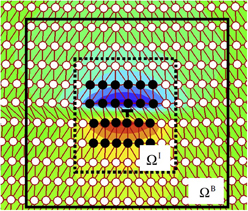Published online by Cambridge University Press: 30 January 2018

We review two recent advances in coupled quantum mechanics/molecular mechanics (QM/MM) modeling for metallic materials. The QM/MM methods are formulated based on quantum mechanical charge density embedding. In the first method, QM/MM coupling is accomplished by an embedding potential evaluated via orbital-free density functional theory. The charge density embedding in the second QM/MM method is achieved through constrained density functional theory. The extension of QM/MM coupling to the quasicontinuum method is illustrated, offering a route toward quantum mechanical simulations of materials at micron scales and beyond. The theoretical formulations of the QM/MM methods are discussed in detail. We also provide some examples where the QM/MM methods have been applied to understand fundamental physics in a wide range of material problems, ranging from void formation, pipe diffusion along dislocation core, nanoindentation of thin films, hydrogen-assisted cracking, magnetism-induced plasticity to stress-controlled catalysis in metals. An outlook to future development of QM/MM methods for metals is envisioned.
Contributing Editor: Steven D. Kenny
This section of Journal of Materials Research is reserved for papers that are reviews of literature in a given area.